Introduction

Welcome to the fascinating world of digital animation! This guide introduces the types of digital animation and the knowledge and skills required for its production, which will be useful for both beginners of digital animation and those who already have some basic knowledge.
What is digital animation?
Digital animation uses computer software to create moving images digitally. It is a genre of computer-generated imagery (CGI) and it can be 2D and 3D animation. Digital animation evolved from traditional animation methods such as stop motion and has become a mainstream way of making animations today.
Digital animation is integrated into various fields, such as entertainment, advertising, education, and business. Animation allows greater freedom of expression and can have lower production costs than filming methods that use actors and sets.
Furthermore, digital animation is also used to simulate advanced and complicated movements, even in the medical and scientific fields. In this manner, digital animation proves to be a diverse and in demand field.
No matter what field of digital animation, an understanding of animation principles and specialized computer software skills and knowledge are required for creating it.
Why is digital animation important?
Digital animation is not just utilized in commercial animation and self-produced animation, but nowadays, it is also used in a wide range of fields such as corporate promotion. Here, we will introduce why animation is considered an important form of expression in various fields.
1. Stronger visual understanding
Due to it’s characteristic movement of continuous images, animation conveys more information and helps deepen visual understanding than conventional still images and drawings. Also, as it is closer to the world that we normally see, the viewers can feel a sense of realism through an immersive experience.
2. Storytelling and communication
A feature of animation is the ability to tell stories with audio in addition to pictures. Therefore, feelings and ideas can be conveyed to the viewer through sight and hearing. Animated works transcend culture and age groups and can connect people together. It is an accessible form of expression for both children and adults.
3. Engagement and attention
Animation is fun, interesting, and captures the viewer’s attention. It can be utilized for corporate content and has the advantage of easily giving a friendly impression.
4. Flexibility and creativity
Digital animation has countless possibilities when it comes to expression. It does not have to be realistic and accurate, creative expression is possible just by using your imagination. Corporate content can introduce a brand’s individuality and promote a unique identity.
5. High adaptability
Animated content can be partially adjusted relatively easily without the need for reshoots. Especially in a fast changing digital world, this makes it a great solution for creating fresh content.
For the above reasons, animation plays an important role in various fields. It can convey your message and strengthen communication with your target audience.
Whether it's commercial animation, self produced animation, or corporate content, digital animation delivers visual storytelling, creativity, and engagement to effectively communicate ideas, and leave a lasting impression while entertaining viewers.
In this manner, digital animation has become an important aspect in today’s media.
Digital animation for beginners

Generally, digital animation is considered to be specialized and require advanced knowledge and skills, but even beginners can get started. Creating high quality animation may require many years of experience, but the basics are an easily approachable area of expression. By using creative apps that are easy-to-use even for beginners and with the right resources, anyone can enjoy creating digital animation!
What are the basics for digital animation?

In order to understand the basics for digital animation, we will highlight the important points here.
Definitions
Animation is a process of creating movement and changing shape by displaying images continuously in quick succession.
Main types of animation
- 2D animation: 2D characters and backgrounds are drawn by hand or using computer software to move to tell a story. Early Disney movies and popular cartoons like The Simpsons were created by 2D animation.
- 3D animation: can express movement with depth in three dimensions. Move characters and objects through complex processes like setting 3D modeling* and developing motion paths. 3D animation is widely used in video works such as movies and video games.
*Mechanism for moving 3D models
Principles of animation
The basic principles of animation creation proposed by Disney Studio animators still influence many animators today. These are the fundamental elements necessary for creating high-quality and charming animations. Some principles include, “Squash and Stretch”, “Anticipation”, and “Timing”. These will be introduced in more detail in “Necessary skills and knowledge for animators”.
Learning resources
There are various helpful resources for learning digital animation, such as online courses, books, and tutorial videos. The following are learning resources recommended for beginners.
- Online courses: These can be taken from anywhere as long as you have a playback device and, in some cases, animation production software. Start off with content for beginners first, like an animation foundation course. Usually, these are courses that comprehensively cover the basic character animation principles and the 12 principles of animation.
- Online tutorials and YouTube channels: Video platforms like YouTube are helpful for beginners to learn animation techniques by themselves. Creative software developers and creators provide practical and informative tutorials and guides. You’ll find many videos if you search “introduction to digital animation” on a video platform. For example, subscribing to the Clip Studio Paint YouTube channel will support your creative activities.
Try your hand at creating simple works while learning the basics with online courses and tutorials! Being able to create a complete digital animation requires practice and the strength to keep at it. Start with the basics, understand the animation principles, and slowly your skills and creativity will improve.
Is learning digital animation difficult?

Digital animation may feel difficult for beginners to learn at first, as it uses graphic software and the creation process is complicated. Here we will introduce some obstacles when it comes to learning animation and hints for continuing to learn the skills for a digital animation beginner.
Important points for learning digital animation
Some obstacles to learning animation
First, it can take over a year to achieve a level of proficiency in developing your skills. In order to produce a satisfying work, you will learn several elements such as creativity, drawing skills, and understanding tools. Learning animation creation skills requires continuous learning, so you need to maintain your motivation to learn.
Hints for learning animation
Generally speaking, learning in person through educational institutions and animation schools or through online courses is effective and easy. Also, skills for using design app such as Photoshop or Illustrator can be utilized for animation creation.
Continued learning and making habits are essential, and actually creating and experimenting with the process is a shortcut to developing your skills. Start with lower difficulty projects like GIF animations, and build up successful small experiences. Eventually you will level up to try more complex creations that will help you develop your skills and own style.
While learning digital animation requires building up your skills, you can achieve it by creating often and continuing to learn.
Types of animation

There are different genres when it comes to animation, and each has its own techniques and different tools. There’s traditional hand drawn animation, stop motion animation, cutout animation, or 3D animation, which is popular now. What genre of animation are you interested in?
For beginners, it is important to understand each type of animation and decide which format best meets your creative needs. For example, a good introduction to digital animation is GIF animation due to the simple creation process and short production time.
What are the different types of animation?
Animation has several different styles, each with their own characteristics and creation techniques. The following are the representative styles for animation.
Traditional animation |
Commonly known as cel animation. This is a relatively old form of animation. Each frame is hand-drawn on a transparent sheet called a cel, photographed one by one with a camera, and the scenes are connected to create the illusion of movement. Works like “Snow White” and “Sleeping Beauty” were created in this traditional method. |
|---|---|
2D animation |
This method moves characters and text in 2D. The animation is created digitally by using hand drawn techniques and computer software. 2D animation is generally used in commercial animation, advertisements, and tutorial videos. There are also short length works such as cutout animation and GIF animation that are constructed with a small number of frames. |
3D animation |
3D animation moves characters and objects in 3D. By moving computer-generated images, it gives realism to characters, etc. It is widely used in movies and video games and is the mainstream style now. |
Motion graphics animation |
A style that animates text, logos, and illustrations. Often seen in titles, opening and ending scenes for movies and TV programs, and advertisements. |
Stop motion animation |
It gives the illusion of movement by manipulating real physical objects, taking pictures one frame at a time, and then playing them back in sequence. This method can be seen in works like “Wallace and Gromit” and “Shaun the Sheep”. |
Motion capture animation |
As the name suggests, it records the movement of actors and props and converts those movements into data. It is a method of animation by combining separately prepared 2D and 3D character and object data. Used in video games and movies, it recreates realistic character movements. |
Check out the following article if you want to learn even more about animation techniques.
Tools and techniques for digital animation
Which animation type is the best for beginners?

Here we’ll introduce animation that is easy for beginners to start creating. The following are the representative genres.
2D animation
This is a traditional animation method in which images drawn one by one are connected consecutively and played back at high speed to give the illusion of movement. It is ideal as an introduction to animation, and the software and learning content required for 2D animation creation are relatively inexpensive and easy to use.
Motion graphics animation
This is an animation method often seen in presentation videos. Made up of animated graphics and text, it is easy for beginners to learn and popular for creating engaging content.
Stop motion animation
This is an animation method that takes pictures of objects and characters in a series of movements and then playing it back in sequence. It is a simple and enjoyable method, and can be easily created with a standard digital camera or a smartphone’s built-in camera.
Whiteboard animation
This is an animation method of drawing text and objects on a whiteboard and recording that process to create a video. It is a popular style of video for educational content and product introductions, as well as be relatively easy to learn the production skills.
2D animation and motion graphics have inexpensive production software and a lot of educational content, so it is a an easy genre for beginners of digital animation to start with. It is important to examine your interests, goals, and available resources.
On the other hand, even if you feel that this is far from a piece of cake, feel the joy of creating by trying out a style that you like! No matter what genre, you are sure to discover the joy of creating digital animation.
CLIP STUDIO PAINT PRO
for character art, concept art, illustration
CLIP STUDIO PAINT EX
for comics, manga, webtoons & animations
PRO
EX
Single-page illustrations & comics
Multi-page comics/manga & illustrations
Up to 24 frames for gifs or short animations
Unlimited frames for professional animation
Natural, customizable pen and brush tools
Vector layers
More than 10,000 free downloadable brushes and materials
3D models and drawing figures
PSD compatibility
RGB and CMYK compatible
For macOS and Windows
-
Export and print multi-page files
-
Convert images and 3D models into lines and dot shading
Free technical support
Free web services & community
Clip Studio Ask / Assets / Tips / Share







